Extend Your Season With an Old Fashioned “Hotbed”
Whether you live in zones 1 to 3 or you are in the mountains, where the growing season is challenging, a natural hotbed will extend your season. Read more to learn an inexpensive, frugal solution.
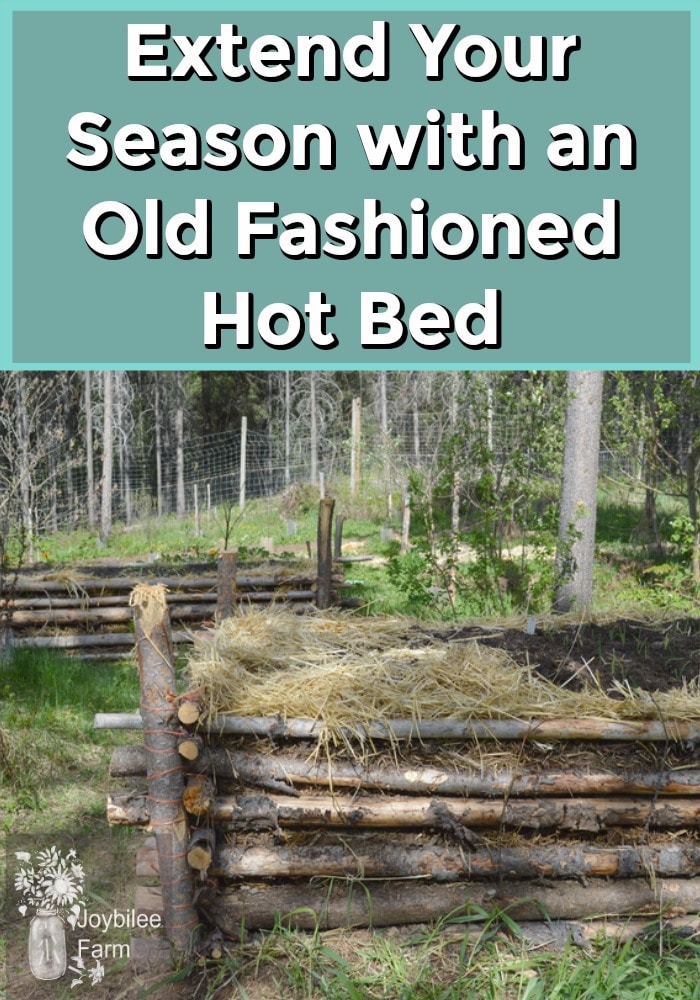
Our pioneer ancestors knew that manure was a hot commodity. They would shovel out the stalls and coops and cover their manure piles with sawdust or straw, to keep the valuable nitrogen, phosphorus, and potassium in the pile and out of the air. A sweet-smelling barnyard was evidence that the manure pile was preserved for fertility.
Manure piles, being rich in nutrients, naturally heat up. You could tell the manure pile because it didn’t stay covered in the snow very long, just like the septic tank. You’ve seen this same science at work when you’ve piled up the grass clippings on the lawn and then moved the pile a day or two later. The grass pile was steaming and most likely looking a little ashen. You can take advantage of this natural energy and chemical reaction, in the manure pile or any other nitrogen-rich compost, by putting it where both the fertility and warmth will do the most good. Use it to make an old-fashioned hotbed to extend your growing season.
How to make a Hotbed
Old fashioned hotbeds take advantage of the warmth of uncomposted manure, trapping it well below the root zone of plants and giving off the heat at night to warm and protect tender plants. Whether you live in zones 1 to 3 or you are in the mountains, where the growing season is challenging, a natural hotbed will extend your season. It can give you a harvest from heat-loving vegetables like tomatoes, cucumbers, squash, maybe even melons, which are usually failures in these harsher gardening zones.
Making an old-fashioned hotbed is a lot like making compost, making a hugelkultur bed, or lasagna gardening. You build it in layers of carbon and nitrogen – but in the old-fashioned hotbed, the nitrogen comes from fresh, not composted manure. Not to worry, though, the bed doesn’t smell at all. But it does get warm. Very warm.
Carbon layers
- Straw
- Wood chips
- Branches
- Stumps
- Logs
- Shredded paper
- Shredded cardboard
Nitrogen Layers
- Fresh manure
- Grass Clippings
- Urine
- Green leaves
- Vegetable waste
- Blood meal
Just like when building a compost pile, there are a few things you want to avoid, because they will attract wildlife, vermin, or flies to your bed. Some things, like oil, will also slow down the decomposition, and you won’t get the heat that you are looking for, so avoid adding that to your hotbed.
Avoid adding:
- Milk or milk products
- Bread or grains
- Meat
- Fat or oil
- Sugar or syrup
- GMOs
- Pesticides or herbicides
- Diseased vegetable material
- Plastics
- Chemicals
- Glass
Neutral additions
Some things that you may want to add to your hotbed, that doesn’t affect the heat action but enhance the fertility of the bed are:
- Phosphate rock
- Bone meal
- Bones
- Ashes from wood
- Dolomite lime
Doing it the old-fashioned way
The traditional way to build a hotbed is to dig down 2 1/2 feet. Add fresh manure to a depth of a foot. Cover with finished sifted compost and place a cold frame over it. In a few days, the bed will be ready to plant. Once the fresh manure is composted, the warmth stops. This gives you a month or so of early-season warmth, which helps if you live in zone 5 or 6. If you live in zone 3 or lower, you need that warmth to last the full growing season, if you want to grow tender plants, and for that, you need a more elaborate construction.
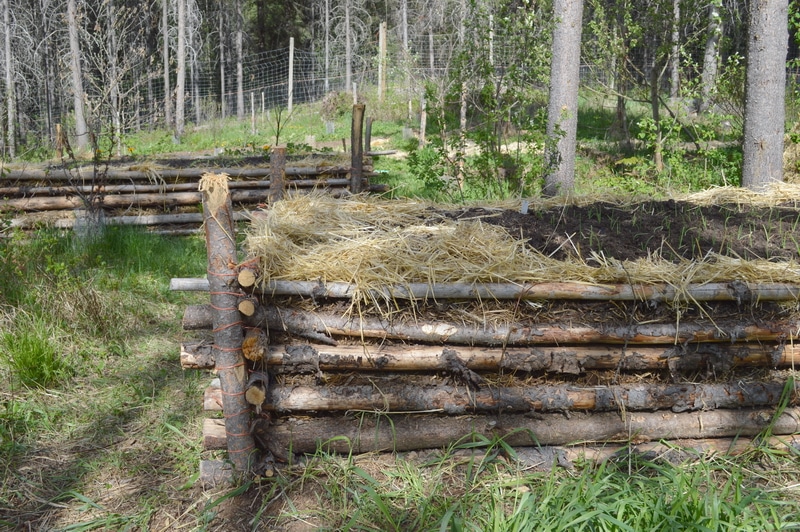
A hugelkultur hotbed
The hugelkultur bed makes the best hotbed to extend the warmth for the full growing season.
- It contains mass that holds in heat.
- It has more mass to decompose longer
- It is raised to keep the frost below the plants’ level
- It will give off heat for a season and can be planted for years
- It takes advantage of natural physics – heat rises
- It is built from waste materials
- It takes only 4 to 5 hours to build
- It has a use beyond a single season
You’ll want to make a new hugelkultur hotbed each growing season. Last year’s hotbed becomes this year’s hugel-bed garden. It still warms up sooner in spring, but in the second year, it no longer gives off its own warmth.
When making a hugelkultur hot-bed, you’ll want to change how you make the hugel-bed just slightly. You’ll want to use fresh manure, rather than composted manure and smaller logs and branches to increase the surface area between the carbon and nitrogen and give off the most heat. And you’ll want to have a way to cover the bed to hold in heat, while still letting light through.
Mark out the hotbed with cardboard
Don’t be discouraged by the size of the project. You can actually make one in about 4 hours. Begin by marking out the area where you want to put your hugelkultur hotbed. It should be in full sun. Lay down cardboard over the area to make the placement of the bed. My hugelkultur hot-bed is 12 feet long by 4 ½ feet wide. You’ll want yours at least 8 to 10 feet long and at least 4 feet wide, because in this case, mass counts.
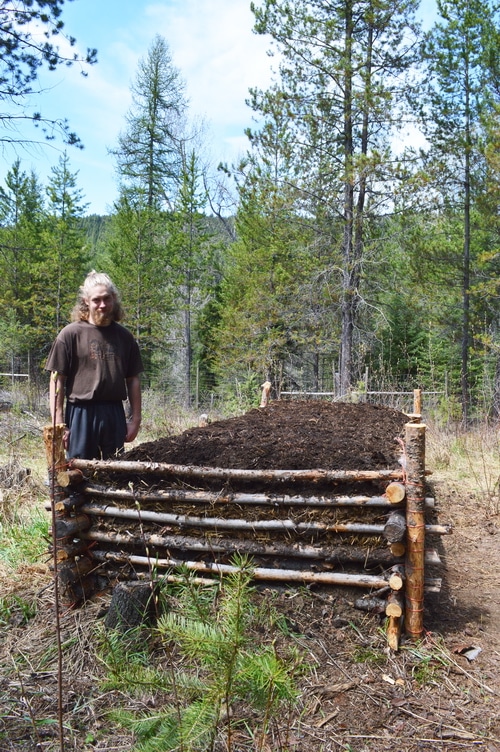
Make a framework with branches to define the sides
Make a framework for the bed, using waste wood and branches with heavier posts in the corners and in the middle of the sides of the bed, and smaller posts and branches tied at the corners to give structural support to the sides of the bed. Build the sides about 4 feet high. The hugelkultur bed will shrink as it decomposes and the sides will keep it upright, and prevent the bed from collapsing. If it shrinks too much during the season, you can add more finished compost to increase the depth of the soil.
Now fill in the hotbed:
First layer: Place branches on top of the cardboard, to cover the surface completely, at least 6 inches deep.
Second layer: Spread fresh manure – llama, rabbit, goat, sheep or poultry – on top of the branches. Be sure to get the manure well into the branches to fill every available space between the branches. Spread the fresh manure at least 6 inches thick on top of the branches. Other kinds of manure tend to be messier to work with, so stick to the kinds of manure mentioned, for this project.
Next layer: Spread wood chips, logs, roots, branches, straw, and other carbonaceous material another foot deep.
Next layer: Layer fresh manure or a mixture of manure and straw, or grass clippings for another foot deep, being sure to get it between the branches of the lower carbonaceous layer and then a full foot over the top of that. This is your heat source. Don’t use finished compost in this part of your layers.
Your hotbed is now about 3 feet deep.
In the next foot of the bed pile on some half-finished compost. A one-year-old manure pile would be the perfect addition to the bed. You can run a rototiller over it to give it a fine tilth – it shouldn’t be fully decomposed yet. Pile it on. You’ll want at least a foot to 16 inches of half-finished compost.
Now press the whole bed down with your hands to be sure that every open space is filled and there are no empty gaps between the logs. Empty gaps are wasted space that will inhibit the bed from heating up, and sustaining that heat.
Now water the bed well or wait for a good soaking of rain. You’ll notice that the heat begins to rise in the bed. In fact, if you push your finger into the bed, you may even recoil – it gets that hot.
As soon as you notice this heat generation – wait 1 week. Plant the bed with your warm loving vegetable transplants or seeds.

Cover the hotbed
Cover the bed to keep the heat in. If you followed my instructions, you’ll be able to make a quick cold frame by using greenhouse plastic, and something to keep the plastic high off the plants.
In my picture, I used the wire hoops that hold political signs on your lawn. I pushed 5 of them into the hugel-bed and covered the bed in greenhouse plastic. I stapled the plastic in place, leaving ventilation holes on the sides, between the logs, so that the hot frame doesn’t heat up too much. You don’t want to cook your plants.
If you aren’t expecting frost, leave the ends open during the day and just cover at night. But if you will be away for several days, you can also add a bed-sheet for shade, to inhibit the sunlight that goes through the film. Internal temperatures can quickly rise to 80 or 90 degrees on an overcast day.
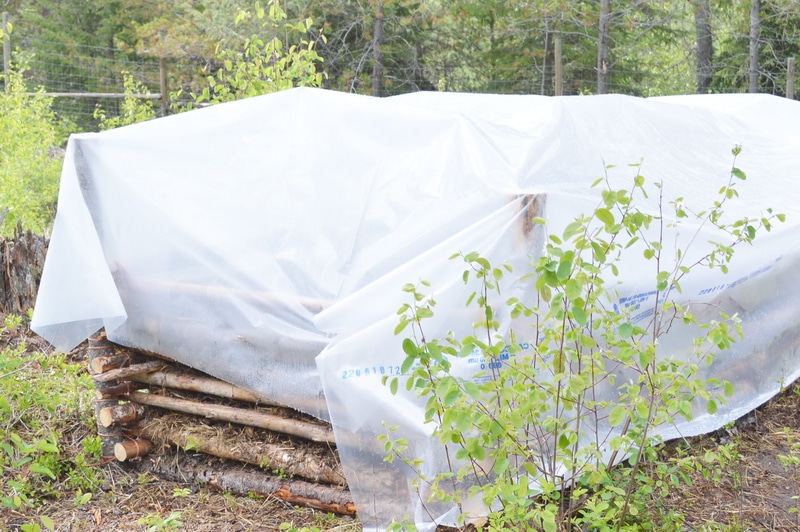
Or try bed sheets
If you don’t want to use plastic, you can also use white, cotton bed sheets – you’ll need 3 Full or queen-size flat sheets, to fully cover this bed. Flannel sheets are ideal, as they hold in more warmth than some of the others. You can pick a few up at the thrift shop and reuse them every season. They will allow some of the warmth to escape but if you are no longer getting frost, they will hold in enough of the heat, to allow the bed to stay warm. Bedsheets also allow some moisture through and won’t allow the hugel-bed to heat up in the sun, the way plastic does. White bedsheets will allow 70 to 80% of the sunlight through to the plants.
Caution: Don’t cook your vegetables
The heat under the greenhouse plastic can rise very quickly. Make sure when you are creating your hotbed, that you create ventilation to allow hot air to escape, while still allowing the warmth to build up inside the bed. On sunny days you’ll want to monitor the temperature inside the hugel-bed, and lift the ends or sides of the hugel hotbed, to prevent heat damage to your plants.
Water your bed regularly, just as you would if your plants were inside a greenhouse. If you can use a drip irrigation system inside your hugel-bed, this is ideal. If not you’ll need to remove the plastic and water the root zone of your plants, and then re-secure your plastic. With the plastic cover, there is less evaporation from the soil surface, than if the bed was exposed to the wind and sun directly, so you’ll water less often.
Now you know how to make a hotbed
The hugelkultur hotbed makes use of waste materials that you already have lying around your homestead – manure, straw, and wood, plus a bit of greenhouse plastic, or cotton sheets, to allow in light and prevent the heat from escaping into the air. It can be built in about 4 hours and will allow you to grow heat-loving plants, extending your season. It is a must for success in zone 2 or zone 3 gardenings. It’s an inexpensive, frugal solution to the problem of growing squash, tomatoes, or melons where the season is short and cold.
Are you gardening in a challenging environment? Have you tried using a hotbed to extend your growing season? Can you share your tricks in the comments, so that we can all benefit? Thanks.



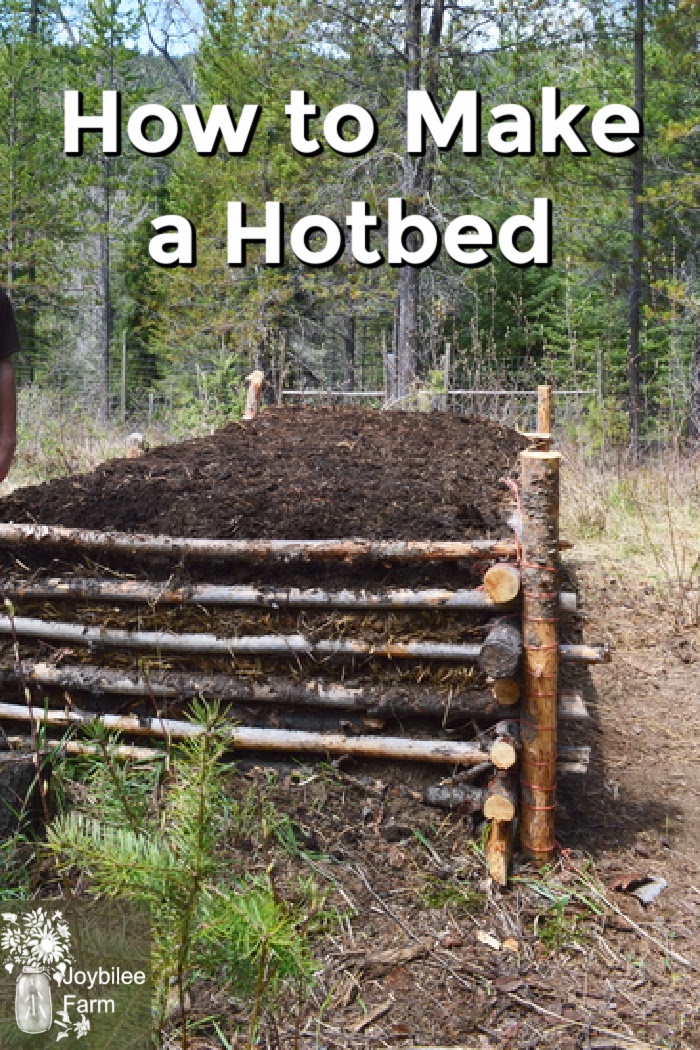

I have learned that a compost heap that generates heat should be turned periodically. This is so because as heat is generated, oxygen is used up and unless the more oxygen get to the heap.. it can become anaerobic. Turning the heap prevents an anaerobic state.
*unless more oxygen gets to the heap.
(Falling asleep)
Would sheep’s will be a good addition to a hotbed and in which layer would you put it?
Doris, yes sheep manure would work in a hot bed. Put it on top of the straw or paper in the bottom of your bed. You don’t want it close to the soil surface where it may burn the roots.
Been toying with this idea for a while now … Been collecting garden waste the whole year … Had garden services dropping off .. Got close to 150 cube covering about 2 acres … Enough for 50 meter by 4 ploy tunnel …But instead of using polythene … Gonna be covering it with 3 layers of bubble wrap … Can always just vent it if it get too hot … Cant always heat it up quick if it gets too cold … Anyone try this with 3 layers of bubble wrap?